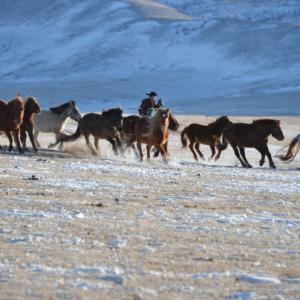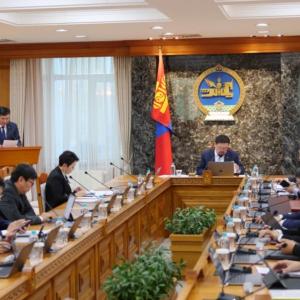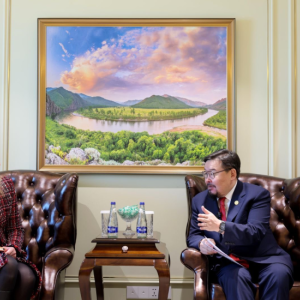Batkhuu Nyam-Osor: Mongolia Will Plant One Billion Trees by 2030 and Increase Forest Cover to 9%
Politics
Ulaanbaatar, August 13, 2024 /MONTSAME/. To combat environmental degradation, climate change, and their negative impacts, countries around the world see tree planting and forest protection as the most effective approach. Therefore, countries around the world are launching large-scale Programs and Movements. For instance, the European Union plans to plant 3 billion trees, Middle Eastern countries 10 billion, Canada 2 billion, and New Zealand and France each aim for 1 billion trees. Mongolia is also contributing by implementing the "One Billion Trees" National Campaign from 2021. We discussed the progress of this National Campaign with Mr. Batkhuu Nyam-Osor, Environmental and Green Development Policy Advisor to the President of Mongolia.
-It has been three years since President Khurelsukh announced at the 76th session of the UN General Assembly that Mongolia will plant one billion trees by 2030. This announcement was likely based on the state of the country's forestry sector. What is the current state of Mongolia's forest resources?
Mongolia's forests grow under extreme climatic conditions at the border between the vast Siberian Taiga and the Central Asian steppe and desert. The natural spread of forests is very limited, and they are highly susceptible to wildfires, pests, diseases, and human activities. Mongolian forests play a crucial ecological role, regulating water resources, preventing soil erosion, moderating climate, absorbing greenhouse gasses, providing habitats for flora and fauna, maintaining permafrost, and mitigating desertification. Our forest resources consist of over 140 species of trees and shrubs. Although Mongolia's forest area is relatively small, the per capita forest area is 5.4 hectares, significantly higher than the global average of 0.54 hectares per person.
-Where are the planned areas for tree planting under the National Campaign?
Mongolia is one of the countries most affected by climate change and global warming. Currently, 76.9 percent of the country's territory is severely impacted by desertification due to climate change. Therefore, President Khurelsukh Ukhnaa undertook to plant a Billion Trees before humanity from the UN platform. By implementing the "One Billion Trees" National Campaign by 2030, we aim to plant a billion trees and increase forest coverage to 9%. This will help reduce desertification and land degradation, enhance greenhouse gas absorption, increase water resources, slow climate change, and boost green development.
We plan to plant 233 million trees to balance urban ecosystems and improve living conditions, 330 million trees to combat desertification and reduce sources of sandstorms and dust storms, 771 million trees to reduce forest degradation and expand forest areas, and 173 million trees to develop specialized agroforestry in line with the "Food Supply and Safety'' National Campaign. In total, we plan to plant 1.5 billion trees.

-How many trees have been planted so far, and what is the survival rate?
Since the National Campaign began, 24 million trees have been planted across 21 aimags and the capital, 8 million by 21 mining companies, and 9 million by governmental and non-governmental organizations. In total, 41 million trees have been planted nationwide, with a survival rate of over 90 percent.
-When the National Campaign was announced, how many tree nurseries existed nationwide, and how many are there now? Are the seedlings sufficient for those who wish to plant trees?
When the campaign began in 2021, there were 306 individuals, cooperatives, and businesses involved in tree nursery activities nationwide. This number increased to 336 in 2022 and 452 in 2023. We have accumulated 12.2 tons of seeds from 39 species, 4.5 times more than in previous years. In 2021, 37 million seedlings were nurtured, and this number increased by 41% to 62 million in 2023. The government supports these businesses with tax incentives, providing MNT 51 billion in tax relief to 25 businesses for 14 types of forestry-related activities.
-Some businesses participate through compensation measures. How much has been raised through these measures so far?
Under a memorandum with “Oyu Tolgoi” LLC, 40 million trees will be planted through compensation measures. Last year, we restored areas in Yalbag Valley, Mandal soum, Selenge aimag, damaged by illegal mining activities through compensation measures. Additionally, we have agreed to finance the expansion of tree nursery capacity with around USD 400,000.
-How are advanced technologies being applied in tree planting?
The decree launching the "One Billion Trees" National Campaign tasked the Government with specific activities in this area. We have initiated pilot research to introduce advanced technologies like water-efficient irrigation technologies, nurturing saplings with a covered root system, and conducting trials and research to implement new global technological solutions, such as seed balls spread by drones, adapted to our country's conditions.
-You mentioned the establishment of specialized agroforestry to plant fruit trees as part of the "Food Supply and Safety" National Campaign. What progress has been made in this campaign so far?
Under the "Food Supply and Safety" National Campaign, we aim to develop agro-forestry and establish fruit tree farms. The "One Billion Trees" National Campaigns strategy and implementation plan include planting fruit trees and shrubs on 19,000 hectares across 190 soums in 21 aimags. The revised "Forest Law" includes provisions for establishing agroforestry, and the Ministry of Food, Agriculture, and Light Industry has incorporated necessary guidelines into its policy documents.
-Mongolia's economy relies heavily on mining. How are mining companies contributing to the national campaign?
To accelerate the National Campaign, we have signed a “Responsibility Agreement” with major mining companies nationwide, planning to plant 680 million trees. Following this model, 21 aimags and the capital will plant 670 million trees, and banking and financial institutions will plant 88.6 million trees under “Responsibility Agreement”, which are being implemented as concrete actions.

-The focus seems to be on tree planting, but less on natural forests. Is protecting natural forests part of this campaign?
Yes, it is. A major part of the "One Billion Trees" strategy and implementation plan is to protect forest resources, enhance natural regeneration, safeguard forests from pests, diseases, and fires, and conduct annual maintenance and cleaning based on research. From 2021 to 2023, we conducted studies on forest pest outbreaks over 5863.9 thousand hectares, identifying outbreak areas, and spent MNT 8.8 billion on pest control. In 2023 alone, we protected 0.9 billion trees from degradation and drying out.
-The forestry sector has been neglected in terms of human resources. What steps are being taken to build capacity in this sector?
To address the shortage of human resources in the forestry sector, we are focusing on short-term training for trainers and offering secondary bachelor's degrees. We have conducted short-term training for 1,000 trainer-teachers, covering 330 soums and training three individuals from each soum. In total, 1,036 people have participated in classroom and field training. Additionally, students with a bachelor's degree in natural sciences or environmental protection can enroll in a two-year bachelor's program in forestry.
Currently, over 50 students are enrolled in this program at the National University of Mongolia (NUM). Nationwide, 266 students are pursuing higher education in forestry. This academic year, vocational training centers and educational institutions have 528 students training as forest maintenance and utilization workers, 37 as forestry enterprise workers, 52 as forest cooperative workers, and 11 as forestry technicians. This year, 32 students enrolled as technicians and 20 graduated as foresters.
 Ulaanbaatar
Ulaanbaatar














































































